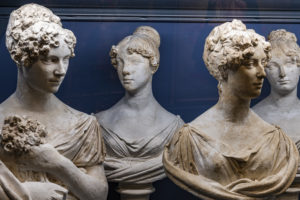Free Entrance to the Accademia & New Displays

To celebrate International Women’s Day on Wednesday, March 8, the Accademia on via Ricasoli will be free to women visitors from 8:15 am – 1:50 pm (last admission 1:20 pm). This day was instituted to celebrate the political, social, and economic advancements of women around the world and in history, presenting an opportunity for the museum to unveil some important changes.
Although most come for the statue of David, the Accademia is also home to a significant collection of paintings and sculptures which is viewed by the almost 500,000 visitors every year. After two years of renovation, the Gipsoteca has reopened to the public to reveal a fresher display of the hundreds of 19th century busts and plaster models, and the Music Room has reopened to exhibit the antique instruments from the 16th century collection of Grand Prince Ferdinando de’ Medici. These exquisite revamped rooms are designed to be more attractive to art and music lovers.
This modern renovation enhances the works of the Lorenzo Bartolini (1777-1850), without taking away from their historic and timeless beauty. The famed sculptor redefined the relationship between Renaissance naturalism and the neo-classic style and his sculptures defined Florentine art during the 19th century. The remodeled room has been designed to emulate Bartolini’s own studio and is enhanced with paintings of former Academy of Fine Arts students, paying homage to both the artist and to tradition. The contrast of the terracotta tiled floor only brings more attention to the marble busts, plaster casts, original clay models, and bas-reliefs that fill the room, as one can’t decide where to look first in the room covered with detailed pieces. When Bartolini was given a commission, he first would complete a clay model of the sitter, which he used to create a plaster cast. While sculpting in marble he would look at the cast to be sure his work in progress was faithful to the original.
The fresh take on the collection is part of a bigger project at the Accademia called BEYOND THE DAVID, which aims to showcase many other works from a wider range of Florentine art. Often overlooked because of the Michelangelo’s masterpiece, the variety of works can be relevant to a larger public. Beginning in 2015, this project, resumed after the pandemic, as the director of the Accademia Cecilie Hollberg explains that the exhibition was in dire need of a modernized makeover, from the aesthetics and structure to the safety and engineering. Besides updating to a more efficient AC system, the walls have been painted the classic Accademia light blue, a new LED lighting system has been put in, the shelves have been remodeled, and the sculptures have been carefully restored and reorganized to maximize the viewing of each of the hundreds of pieces on display.
This project is only one of many the Accademia has undertaken to start the new year with a fresh appearance, both within and outside the museum. The entire front entrance on Via Ricasoli is being renovated to welcome visitors with a new aesthetic aligned with the changes made on the inside. Guests will be delighted to hear that the ticket office and front room will be completely rearranged to encourage a more efficient and less overwhelming entrance into the building. The museum director felt this an important measure to ensure their visitors to feel comfortable when taking those first steps to begin their Accademia experience.
As a grand finale to the changes, the remodeled Music Room delights with the chance to explore some of the original instruments—ranging from harpsichords and wooden trumpets to cellos and the first piano–from the Medici family collection, specifically, the Grand Prince Ferdinando de’ Medici, who surrounded himself with some of the most famed artists of the late 17th century. The section is intimate, a feeling heightened by the paintings of the Grand Prince and artist friends grouped around a musical instrument. One can then see some of these ancient instruments and imagine themselves in the presence of these historically prominent figures. (antonietta damico)
